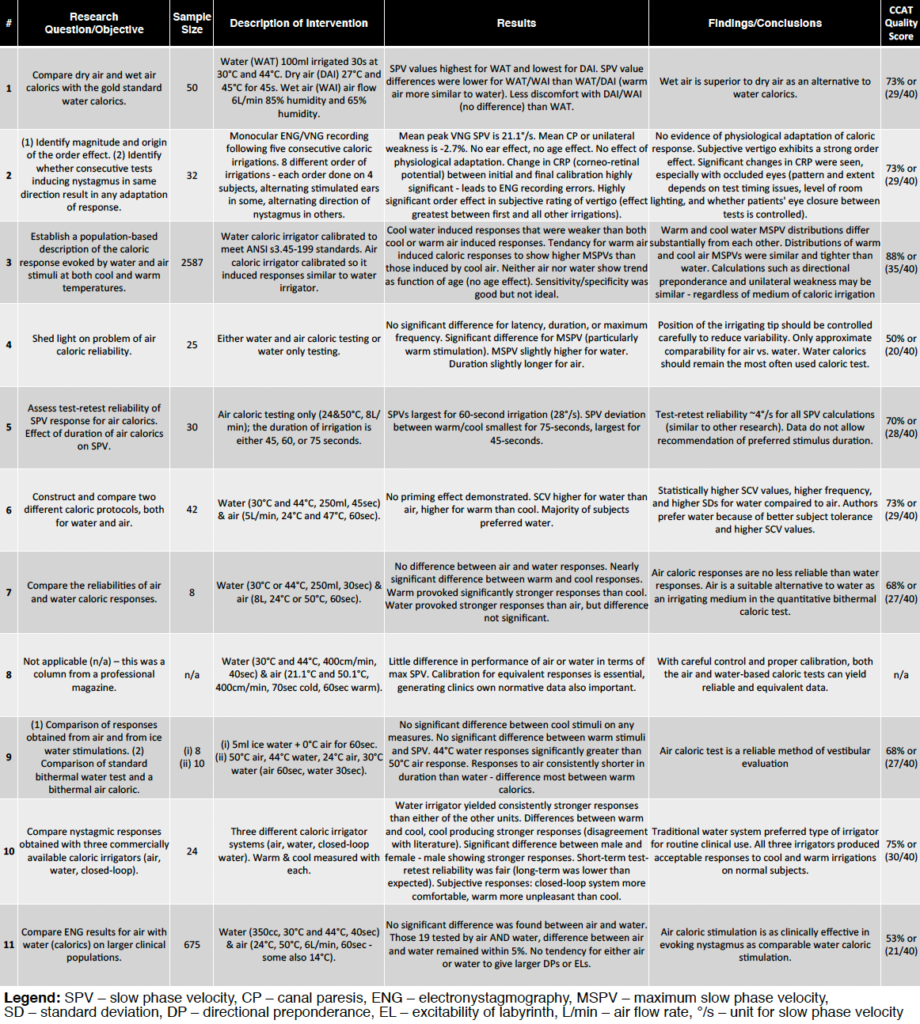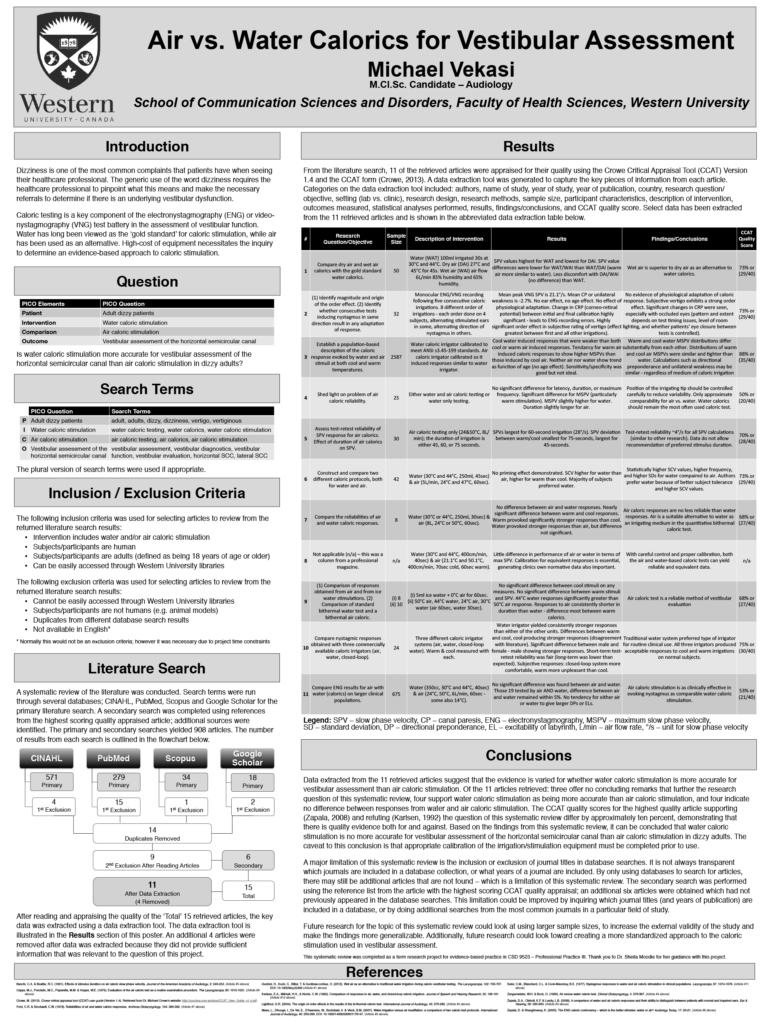Striking the Right Balance: Air vs. Water Calorics for Vestibular Assessment
In this edition of “Striking the Right Balance,” Michael Vekasi, AuD, R.Aud, Aud(C), FAAA, shares a poster presentation on air versus water calorics he prepared during graduate school and given an updated literature search.
Michael Vekasi, AuD, R.Aud, Aud(C), FAAA and Erica Zaia, MSc, RAUD are coordinating the “Striking the Right Balance,” feature which will cover the latest information on ‘all things vestibular.’
If you would like to be more involved in all things vestibular, please check out and like our Facebook page by searching for “CAA National Vestibular Special Interest Group” within Facebook. You can also reach us by email at CAAvestibular@gmail.com.
Introduction
Dizziness is one of patients’ most common complaints when seeing their healthcare professional. However, the generic use of the word dizziness requires the healthcare professional to pinpoint what this means and make the necessary referrals to determine if there is an underlying vestibular dysfunction.
Caloric testing is a key component of the electronystagmography (ENG) or videonystagmography (VNG) test battery in the assessment of vestibular function. Water has long been viewed as the “gold standard” for caloric stimulation, while air has been used as an alternative. However, high-cost of equipment necessitates the inquiry to determine an evidence-based approach to caloric stimulation.
This article has been prepared from a poster presentation created during graduate school at Western University – School of Communication Sciences and Disorders, with an updated literature review. I would like to acknowledge Dr. Sheila Moodie for her guidance and support during the original creation of this poster presentation.
Question
| PICO Elements | PICO Question |
| Patient | Adult dizzy patients |
| Intervention | Water caloric stimulation |
| Comparison | Air caloric stimulation |
| Outcome | Vestibular assessment of the horizontal semicircular canal |
Is water caloric stimulation more accurate for vestibular assessment of the horizontal semicircular canal than air caloric stimulation in dizzy adults?
Search Terms
| PICO Question | Search Terms | |
| P | Adult dizzy patients | adult, adults, dizzy, dizziness, vertigo, vertiginous |
| I | Water caloric stimulation | water caloric testing, water calorics, water caloric stimulation |
| C | Air caloric stimulation | air caloric testing, air calorics, air caloric stimulation |
| O | Vestibular assessment of the horizontal semicircular canal | vestibular assessment, vestibular diagnostics, vestibular function, vestibular evaluation, horizontal SCC, lateral SCC |
The plural version of search terms were used if appropriate.
Inclusion/Exclusion Criteria
The following inclusion criteria was used for selecting articles to review from the returned literature search results:
- Intervention includes water and/or air caloric stimulation
- Subjects/participants are human
- Subjects/participants are adults (defined as being 18 years of age or older)
- Can be easily accessed through Western University libraries
The following exclusion criteria was used for selecting articles to review from the returned literature search results:
- Cannot be easily accessed through Western University libraries
- Subjects/participants are not humans (e.g., animal models)
- Duplicates from different database search results
- Not available in English*
* Normally this would not be an exclusion criterion; however, it was necessary due to project time constraints
Literature Search
A systematic review of the literature was conducted. Search terms were run through several databases: CINAHL, PubMed, Scopus and Google Scholar for the primary literature search. A secondary search was completed using references from the highest-scoring quality appraised article; additional sources were identified. The primary and secondary searches yielded 908 articles. The number of results from each search is outlined in the flowchart below.

After reading and appraising the quality of the ‘Total’ 15 retrieved articles, the key data was extracted using a data extraction tool. The data extraction tool is illustrated in the Results section of this poster. An additional 4 articles were removed after data was extracted because they did not provide sufficient information relevant to this project's question.
Results
From the literature search, 11 retrieved articles were appraised for their quality using the Crowe Critical Appraisal Tool (CCAT) Version 1.4 and the CCAT form (Crowe, 2013). In addition, a data extraction tool was generated to capture each article's key pieces of information. Categories on the data extraction tool included: authors, name of study, year of study, year of publication, country, research question/objective, setting (lab vs. clinic), research design, research methods, sample size, participant characteristics, description of the intervention, outcomes measured, statistical analyses performed, results, findings/conclusions, and CCAT quality score. Select data from the 11 retrieved articles are shown in the abbreviated data extraction table below.

Conclusions
Data extracted from the 11 retrieved articles suggest that the evidence is varied for whether water caloric stimulation is more accurate for vestibular assessment than air caloric stimulation. Of the 11 articles retrieved: three offer no concluding remarks that further the research question of this systematic review, four support water caloric stimulation as being more accurate than air caloric stimulation, and four indicate no difference between responses from water and air caloric stimulation. The CCAT quality scores for the highest quality article supporting (Zapala, 2008) and refuting (Karlsen, 1992) the question of this systematic review differ by approximately ten percent, demonstrating that there is quality evidence both for and against. Based on the findings from this systematic review, it can be concluded that water caloric stimulation is no more accurate for vestibular assessment of the horizontal semicircular canal than air caloric stimulation in dizzy adults. The caveat to this conclusion is that appropriate irrigation/stimulation equipment calibration must be completed before use.
A major limitation of this systematic review is the inclusion or exclusion of journal titles in database searches. It is not always transparent which journals are included in a database collection or what years of a journal are included. By only using databases to search for articles, there may still be additional articles that are not found – which is a limitation of this systematic review. For example, the secondary search was performed using the reference list from the paper with the highest scoring CCAT quality appraisal; an additional six articles were obtained which had not previously appeared in the database searches. This limitation could be improved by inquiring which journal titles (and years of publication) are included in a database or by doing additional searches from the most common journals in a particular field of study.
Future research for the topic of this systematic review could look at using larger sample sizes, to increase the external validity of the study and make the findings more generalizable. Additionally, future research could look toward creating a more standardized approach to the caloric stimulation used in vestibular assessment.
This systematic review was completed as a term research project for evidence-based practice in CSD 9523 – Professional Practice III. Thank you to Dr. Sheila Moodie for her guidance with this project.
Author Remarks
An updated literature search was completed using the same databases and search terms as the original literature search but limited to studies completed between 2014 and 2023 (to account for the time after the original literature search). Based on the original inclusion and exclusion criteria there were no additional articles to be added to the results.
It is important to note that use of air caloric irrigators has a variety of controversies within the vestibular audiology community. Two prominent organizations have varying stances on air calorics – the American National Standards Institute (or ANSI) does not include air caloric irrigators in their most recent set of standards. At the same time, the British Society of Audiology (or BSA) considers air caloric irrigators suitable for use clinically (McCaslin et al., 2021). While both air and water caloric irrigators can (and are) used in clinical practice today, it is very important to understand that the clinician must have the technical skills to appropriately use each type of irrigator to ensure an accurate caloric response is being measured. A final consideration is that the original literature search and project was completed during graduate school, before having experience with vestibular audiology.
Original Poster

References
- Banchi, C.A. & Beattie, R.C. (1991). Effects of stimulus duration on air caloric slow phase velocity. Journal of the American Academy of Audiology, 2: 246-252. (Article #5 above)
- Capps, M.J., Preciado, M.C., Paparella, M.M. & Hoppe, W.E. (1973). Evaluation of the air caloric test as a routine examination procedure. The Laryngoscope, 83: 1013-1021. (Article #9 above)
- Crowe, M. (2013). Crowe critical appraisal tool (CCAT) user guide (Version 1.4). Retrieved from Dr. Michael Crowe’s website: http://conchra.com.au/docs/CCAT_User_Guide_v1.4.pdf
- Ford, C.R. & Stockwell, C.W. (1978). Reliabilities of air and water caloric responses. Archives Otolaryngology, 104: 380-382. (Article #7 above)
- Gudziol, H., Koch, C., Bitter, T. & Guntinas-Lichius, O. (2012). Wet air as an alternative to traditional water irrigation during caloric vestibular testing. The Laryngoscope, 122: 703-707. DOI: 10.1002/lary.22493 (Article #1 above)
- Karlsen, E.A., Mikhail, H.H., & Norris, C.W. (1992). Comparison of responses to air, water, and closed-loop caloric irrigators. Journal of Speech and Hearing Research, 35: 186-191. (Article #10 above)
- Lightfoot, G.R. (2004). The origin of order effects in the results of the bi-thermal caloric test. International Journal of Audiology, 43: 276-282. (Article #2 above)
- Maes, L., Dhooge, I., De Vel, E., D’haenens, W., Bockstael, A. & Vinck, B.M. (2007). Water irrigation versus air insufflation: a comparison of two caloric test protocols. International Journal of Audiology, 46: 263-269. DOI: 10.1080/14992020601178147. (Article #6 above)
- McCaslin, D. L., Janky, K., Burkard, R. F., Barin, K., Shepard, N. T., & Jacobson, G. P. (2021). Balance function assessment and management (Third edition.). Plural Publishing.
- Suter, C.M., Blanchard, C.L. & Cook-Manokey, B.E. (1977). Nystagmus responses to water and air caloric stimulation in clinical populations. Laryngoscope, 87: 1074-1078. (Article #11 above)
- Zangemeister, W.H. & Bock, O. (1980). Air versus water caloric test. Clinical Otolaryngology, 5: 379-387. (Article #4 above)
- Zapala, D.A., Olsholt, K.F. & Lundy, L.B. (2008). A comparison of water and air caloric responses and their ability to distinguish between patients with normal and impaired ears. Ear & Hearing, 29: 585-600. (Article #3 above)
- Zapala, D. & Shaughnessy, K. (2005). The ENG caloric controversy – which is the better stimulus: water or air? Audiology Today, 17: 20-21. (Article #8 above)

